Music-Dance 2023
An aesthetic ethic: vicarious excursions of relational bodyminds
During November-December 2023 the 6th iteration of Music-Dance 2023 took place at Theatre Arts in Observatory, Cape Town. This year the event was again guided by Thalia Laric and Manuela Tessi, two stalwarts of real-time composition amongst dancers and musicians. The event spanned a few weeks of gatherings, workshops, rehearsals and performances.
Music-Dance is always blended with newcomers, and ever-fresh new vocabularies of improvisation, the making of dances and music with all the vicarious talents of listening and more techniques of this high art form of relationality. It also took place within the larger context of the Middle Eastern war which never really escaped me and which I had kept within my real-time template of dances and that of being an observer of others' dances and music.
The rehearsals and performances I participated in were with a cast of five artists, Thalia and Manuela, Ben Brown from Canada on percussion, Coila-Leah Enderstein on piano and Mark Hurrell, the saxophonist. This variety of instruments and the bodymind template that I have developed with Thalia and Manuela over years provided for a fecund abundance towards the unknown spaces that real-time creations afford us.
Here are some images of a warm-up between Manuela and myself. Technically, we attune with forces of touch, a visceral listening, breath, a variation of temporalities within different parts of our bodyminds, the surrender to gravity separate and onto each other's bodies, all taking place within a cacophony of other activities around us of artists exercising the same techniques in their fields.







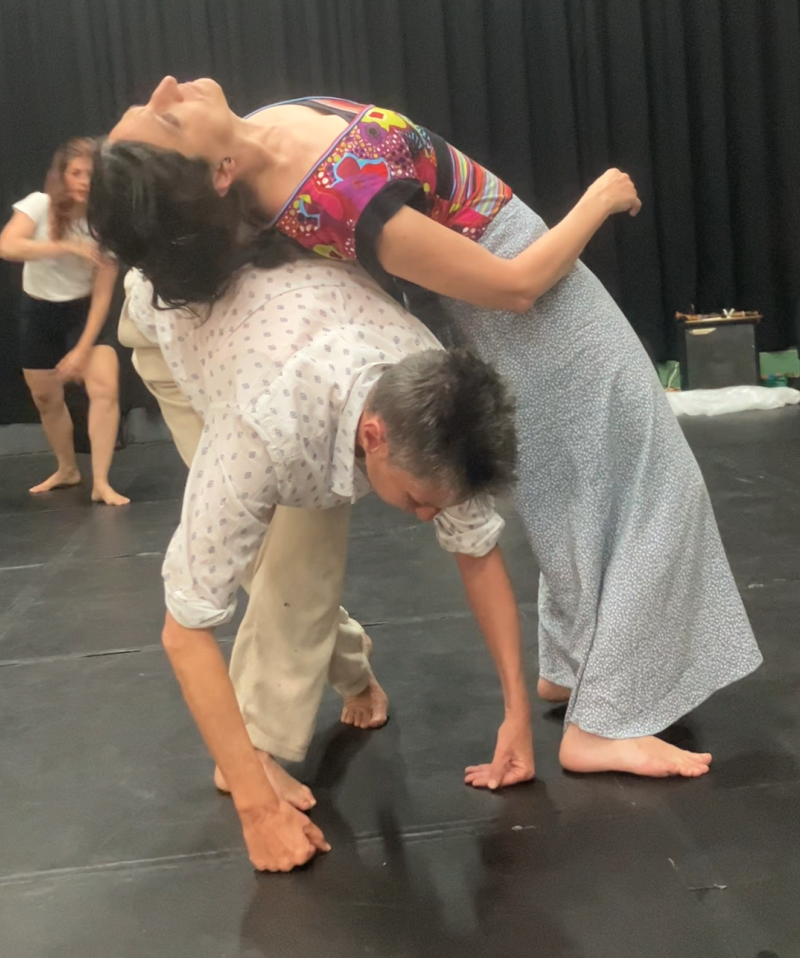
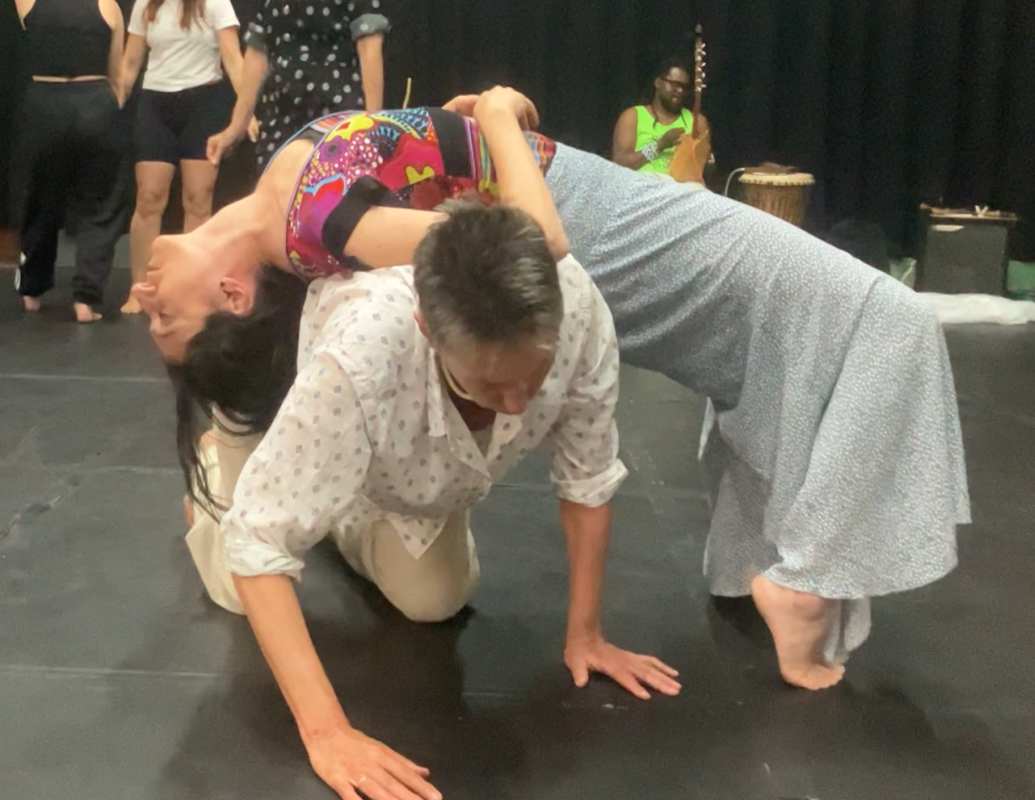
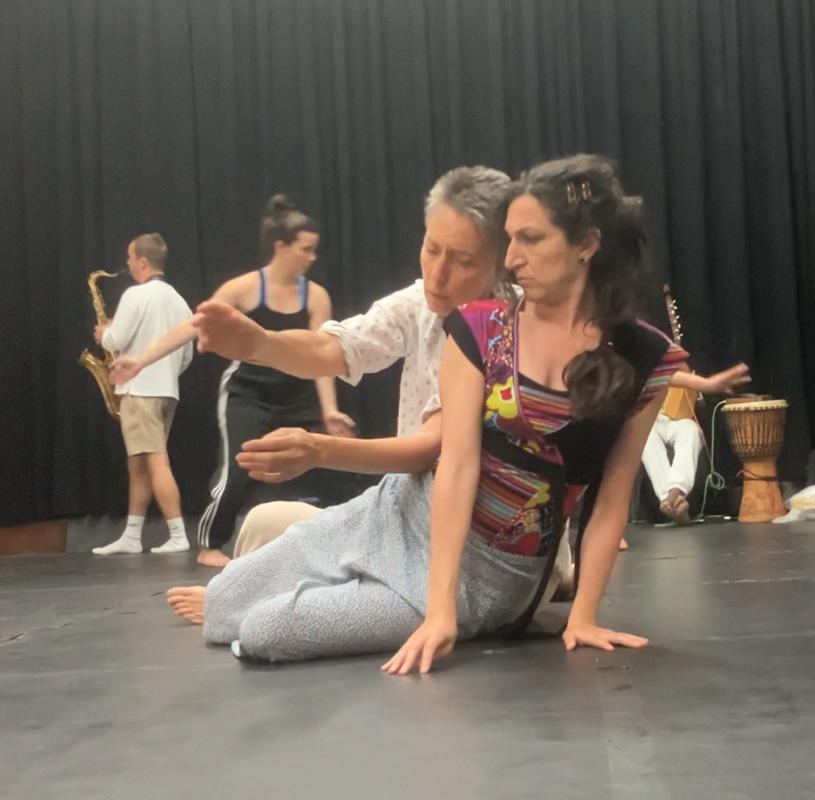
It is only in retrospect that one can "read" the narrative of the real-time composition with some accuracy albeit it still a very subjective one, different for each dancer, and surely musician. It is of significance to mention here that the musicians do not "play for" dancers. We are all in the vortex of creativity together and charged to make integral choices from moment to moment that, as much as possible, respond to authentic impulses of collective significance. I like to compare it to the vortex of creativity. The cosmic forces of a vortex are subject to every element in the universe, such as gravity, for instance, yet the manner in which each micro wave is organizing itself is authentic to its own nature and the other elements in the environment at the same time.
In this performance rehearsal all six of us were on stage all the time. However, the nature of our trio as dancers had a significant pattern shifting amongst the three of us in slow fashion with various "vortices" of relationality. It was like an alchemy with a particular formula. Two dancers and one separate, always alternating, with the one having a specific witnessing quality upon the two. The two ventured into specific dramatic qualities that evoked images and a viscerality of enfoldment, containment, gaze, hands, tumbling, draping, clasping, with strong engagement with hair, backs, hands and an unfolding drama we could not predict. Most of the movement motions had a rolling and irreducible movement poetics of intimacy. The choice of costumes (which did not take up much attention beforehand) played out as a grand feminine exposition of slow self-realisations within the intricate weaving of others', at once. It felt and appeared like a multidimensional narrative of women with a story they were revealing as solo and duo parts, ever intricate. An observer called this "Pietá". And evidence of this theme was shifting to all three of us over the period of the cameo. It vacillated between being and becoming through the other, the relational intelligible and the sensible, the divine and the mortal. Within the gravity of all movement nothing felt fractured or fragile. There seemed to have been a democracy of shifting and shiftable positions between solo and duo. The end marked places of isolation, departures, and silent marginal endings. At the end the centre of our cameo released its hold and freed three dancers to their own sense of destiny across the stage.
In retrospect I found this particular cameo one that offers me self-reflection of the kind that sustained a quality of connectivity with the other dancers until the end when I departed. As these cameos always offer me a view on my own life, I notice how much I invest in the nature of contact between my own and other bodies in a creative act. I also notice specifically in this cameo how much I employ containing gestures from hands or heads, to offering my whole body, and how much I enjoy the fulness of this experience. Pietá is indeed at the core of this cameo for me for a visceral embodiment of the other body draped over mine whether it is in ecstasy, dying, releasing or surrendering the full gravity with such a sense of biblical significance. Being present with my full body under the weight of a body that has "departed" and therefore extra heavy, I could allow myself the full significance of that reality, and even its mystery in my life. This cameo had a significance of a particular humanity which considered the nature of the human body in this intricate, intimate unraveling of a story.
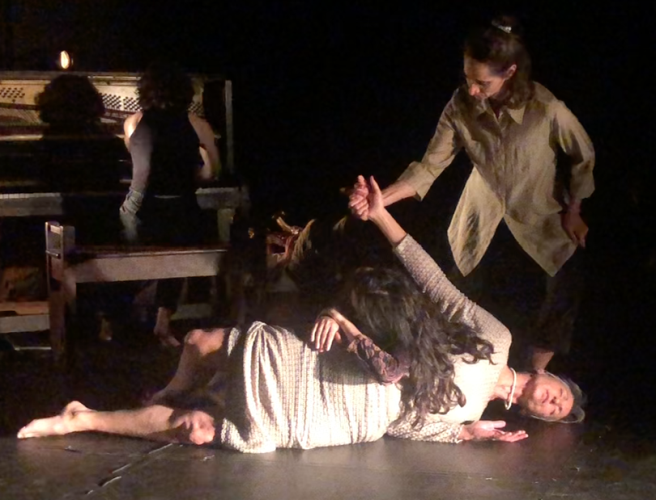

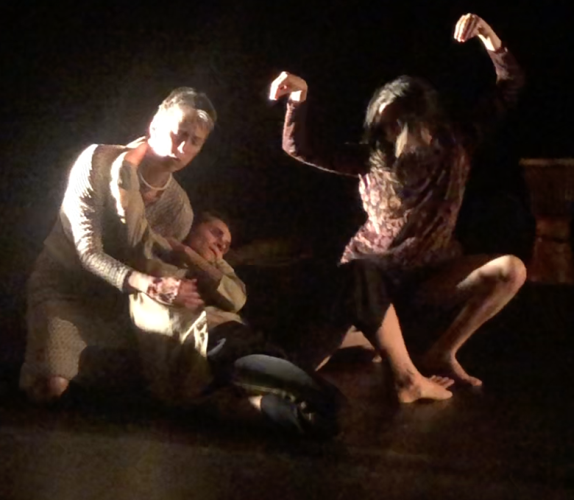
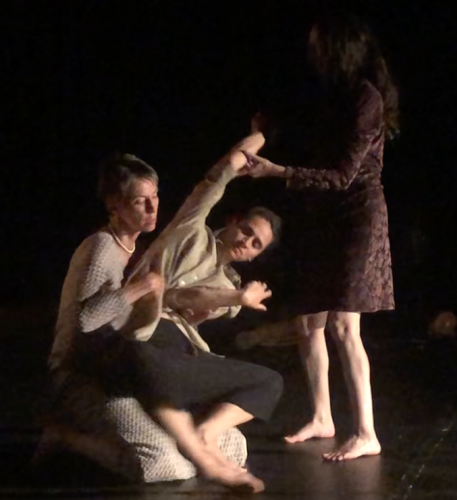


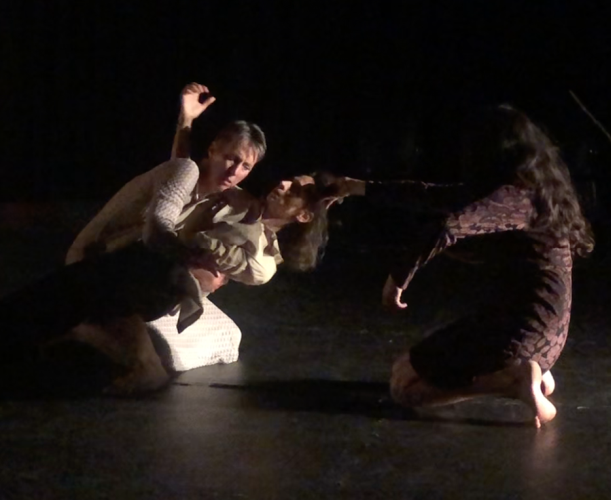
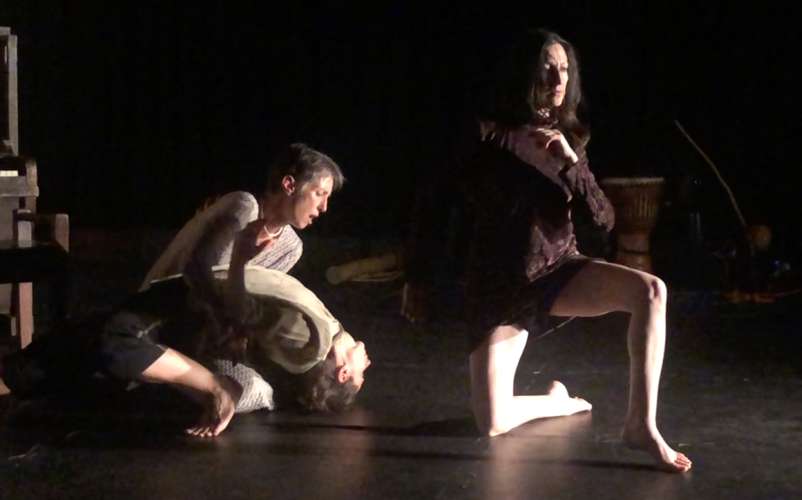



The actual public performance some days later, by the six of us took place with an equal openness as that of us, to our rehearsals. It always interests me what I title a performance the moment the cameo is complete. This performance cast itself in my mind as "Destruction & Survival". The initial dark stage introduced a cacophony of drums and saxophone. The piano responded with a repetitive sameness of notes. The sax warned of something imminent. Something ominous was to be revealed. Thalia displayed a moment of vigilant compassion. Then, if it was a film, the piano notes told us of the imminent scene as reflected in clouds. Back to the scene. Ben the drummer wanted to bring in a march, but it lasted five beats. From the start, and emerging, it felt that we were in a field of combat. Body parts flew past my field of vision. The musicians were on point with a most dramatic scene we were all creating. The human body felt dislodged from its anatomy, dislocated from a resonant field, and proximities were unrelated to something coherent. Imagine a flood, explosion, or tumbling building, all with a slow motion of a violent ecology in which we did not have much control. At times individuals felt as if they were collecting themselves to be tumbled under yet again. Yet, then there were moments of unquestionable gaze towards others, with a silence of realisation, an apprehension that we could meet in a momentary cohesion. Even compassion. And human embrace.
But then a force dislodged the humane factor once again. Survival took the front of action amidst destruction. A body could turn into a ledge onto which one steps to escape. The combat was for the self and other bodies became objects in this endeavour. By the time we were all on our feet, the musicians were drawn into the front of stage of this scene. A violence streamed in. The field was damaging to all and everything present. Surviving at all costs happened at the time when the saxophonist burst through the dancing bodies. His instrument became a weapon with a panting, flipping rhythm without any sound. No one was prepared to let up and release the tension through an exit. All musicians and dancers sustained the high tension albeit in degrees of slow motion. I notice the exasperation on my face. The tragedy rolled out. The soft faces of people out of control flung about. Images I often pay attention to in acts of war, became part of the scene. Suddenly it was all over. Dancers and musicians were separated on the stage, some of us in unusual postures, like stills of the aftermath. What was that? Where are we? Who are we? What have we become? Coila mustered muffled deep notes, asking these questions. The percussionist Ben Brown walked with one part of his drum kit and stand onto the scene of the aftermath, lowering onto his knees. I contorted. Thalia wriggled rapid contortions in an isolated space. I supported Manuela to lower by holding her head. Next, she was on my back and Thalia contorted backward towards us. I landed on my back with the two dancers on my sides. It was the aftermath, people disheveled. Manuela sustained her arms softly in a cross to her body. Thalia opened her hands in a revelation of what was in her palms, then rested her hands on my legs and later on her own, a gesture of what was a re-turn, to be recognized as human. Colia-Leah offered the last piano notes with Ben's soft drumroll into a fading light by most tuned up and sensitive lighting technician, Frans Mandilakhe.









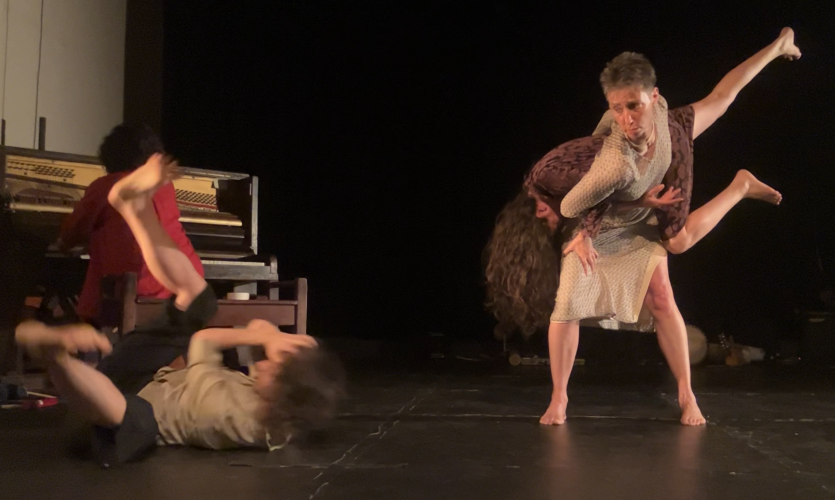

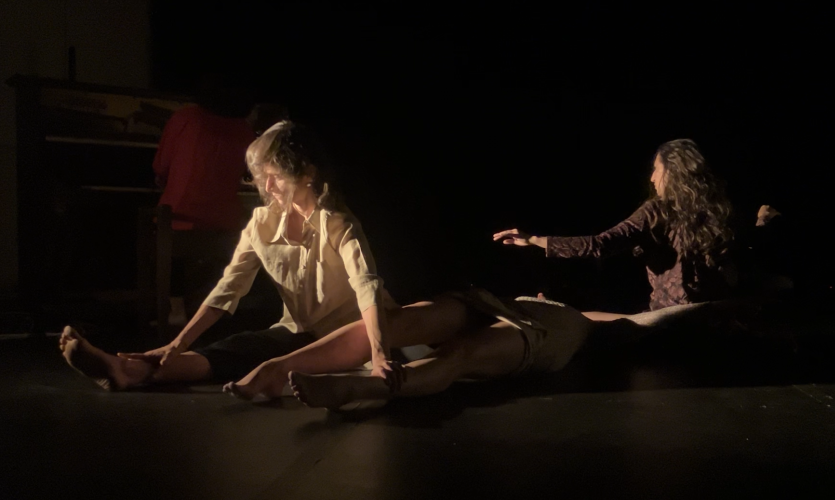
Here is the video of the final performance:
